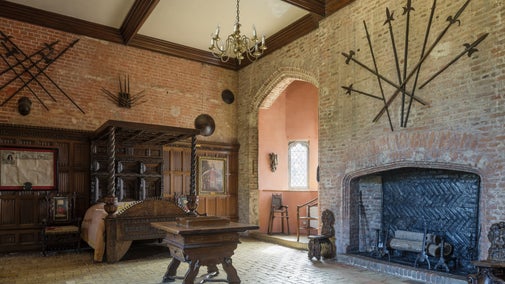The rise and fall of the Bedingfelds
The Bedingfelds’ unshakable Catholic faith and commitment to preserving their history are a potent combination, expressed throughout this remarkable place in its architecture, collections and landscape. Add to this the family’s strong royal connections and a powerful story unfolds.
But when Henry VIII became head of the Church of England, little could the Bedingfelds have foreseen how their religious beliefs could have consequences for successive generations.
Power and prestige
Built around 1482 in highly fashionable red brick, Oxburgh was intended to reflect the newly acquired status of Sir Edmund Bedingfeld at royal court. A rising star, he was knighted and even hosted a visit from the king and queen. A further 100 years of royal service and patronage followed, when the Bedingfelds' fortunes flourished. Their support of Catholic Mary I in her claim to the throne brought the family unprecedented power and prestige.
Persecuted for their faith
With the succession of Elizabeth I, the family’s fortunes changed dramatically. The Act of Uniformity in 1559 outlawed Mass and it became illegal not to attend the parish church for the Anglican rite. The Bedingfelds’ refusal to change their faith after the reformation cost the family dearly, both politically and financially.
The late 16th century became a time of great danger for those who didn't conform. Catholic priests were routinely tried and executed and Catholic gentry who gave shelter to priests were imprisoned. Catholic families retreated into their recusant communities and were obliged to conceal their worship by building secret chapels and priest holes. For 300 years the Bedingfelds were subjected to heavy taxation and exclusion from public office and education.
A brief return to prosperity
Under King Charles I, there was a brief relaxation in religious persecution. Fines were less rigorously collected and priests were no longer hunted down. The Bedingfeld family began to prosper again but this would be short lived.
Punished during the Civil War
The Civil War was catastrophic for the family. Sir Henry Bedingfeld was captured by parliamentary forces and imprisoned in the Tower of London. One of his sons was shot, the Hall was ransacked and the East Range was gutted by fire. The property was confiscated by Parliament and later sold back to the family at an extortionate price, and they were also fined a further £20,000.
The Bedingfelds’ losses were unusually severe, even for Catholics. The reason for this was that they were both Catholic and had served in the Royalist army. Very few East Anglian Catholic families took up arms to defend the king.
Stability, hope and hardship
With the restoration of Charles II to the throne in 1660, the Bedingfelds hoped they would finally be compensated for their losses. Unfortunately they would be disappointed and the family's fortunes remained constrained. They did, however, receive a baronetcy in reward for their loyalty.
The family's continued refusal to conform after the Civil War meant further financial penalties and political ostracism, so the family retreated socially. They married fellow Catholics, educated their children abroad, served in foreign armies and spent increasing amounts of time on the continent as nuns and priests.
From the 1770s, the Bedingfelds' fortunes stabilised. They returned to public office and royal court, though by this time 300 years of heavy taxation and repression had taken its toll. The house and its relative isolation became a sanctuary, a retreat and a symbol of the family’s defiance.







